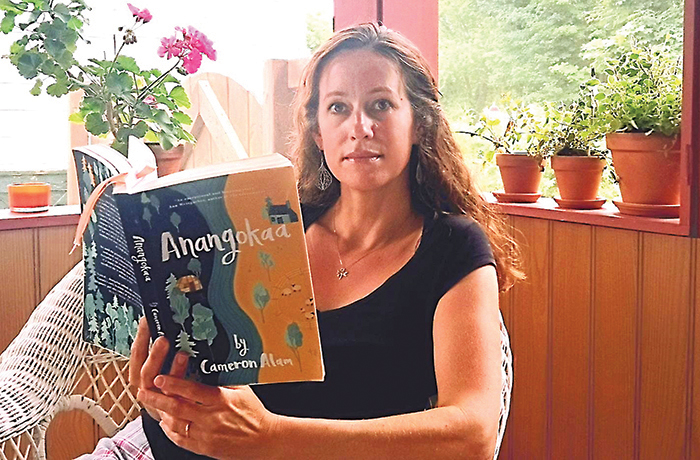
By Pam Wright
Local Journalism Initiative Reporter
In the Ojibwe language, Anangokaa means “many stars.”
It’s the word author Cameron Alam chose for the title of her debut novel that tells the coming-of-age story of a 14-year-old Scottish immigrant who comes to the wilderness near Walpole Island in 1804.
Punctuated by devastating loss, love, and the wonder of discovery, the story is told from the viewpoint of young Flora MacCallum as she navigates her first Canadian winter, while forging a forbidden friendship with the son of a Chippewa chief, all within the confines of the strict social rules of the times.
Alam said the story started “percolating” with her seven years ago as she began researching her family history. Her husband Richard Alam, who is in the Canadian military, was stationed in the United Kingdom. While there, the family ended up spending a month on the Isle of Mull in the Scottish Hebrides.
“I made so many discoveries there,” Alam said in a recent interview from her home in Prescott near Ottawa, noting the experience nudged her into diving deep into exploring her ancestors on the MacCallum branch of her family tree.
She then discovered the real-life Flora MacCallum, which led her to become the protagonist of Anangokaa. Melding fact with fiction, Alam details what life was like at the turn of the 19th century for European settlers. The McCallums were among 15 families who settled along the Chenal Ecarte – also known as the Snye River – in the northern portion of Kent County. The settlers had agreed to work on Lord Thomas Douglas Selkirk’s farm for a time in exchange for free passage and a 50-acre piece of land.
“Flora is a real ancestor of mine,” Alam said. “I decided to tell the story through her eyes as she moves through the years.”
It wasn’t easy for the immigrants, Alam said, noting Flora lost both parents and a sibling shortly after reaching the Baldoon settlement, in what was known at the time as Upper Canada. The Baldoon Settlement was part of a plan by Selkirk, who handpicked the Scottish immigrants to settle in the New World.
After a perilous journey across the Atlantic, the settlers encountered stark conditions, malaria and also faced raids relating to the War of 1812.
“They had to be fighters, especially those that were highlanders,” Alam explained.
The creation of Anangokaa led Alam and her husband to undertake countless hours of painstaking research. The archives offer little information about women beyond birth, death and marriage dates.
“It was pretty interesting for me, discoveries like finding a name on a ship roster,” Alam said. “You sometimes get lucky, but you can also go down rabbit holes.”
In the years prior to Canada’s birth, few historical records exist, so that led Alam to researching Indigenous treaties and writings, dissertations, academic papers and studies of ethnobotany for the book.
“That helped me feel like I could saturate myself in what Flora experienced,” the author said, but added there is a lot of fiction in Anangokaa as so little is known.
However, Flora’s older brother Hugh MacCallum, who became Wallaceburg’s first postmaster and is the person responsible for naming the town after William Wallace, left behind a treasure trove of written material and letters.
“Hugh was a portal into the story,” Alam said. “I felt like I heard his voice speaking to me all the time.”
Alam said she paid careful heed to the Indigenous piece of the story, acknowledging European settlement in Canada is also about early colonization.
“It’s a tumultuous part of history for us,” Alam said, noting she wanted to showcase the breadth of knowledge carried by Canada’s Indigenous people.
Key to the story is when Flora is honoured by her young Indigenous friend who bestows her with the name Anangokaa, Alam said.
Born in Buffalo, New York, Alam had little knowledge of Canadian history and the role her ancestors played in their new country. She discovered that some family members moved from the Wallaceburg area to Detroit to work in the auto industry. She’s learned she’s also related to the McDougall family, who joined the McCallum family through marriage. Since that time, she’s made some close connections to her new-found relatives in the Wallaceburg area.
One of them is Wallaceburg resident Barbara Thornton.
“I found her and she has been so generous with her time,” Alam said. “We’ve been the best of friends ever since. We’re kindred spirits.”
Published in March of this year, Anangokaa is already receiving great interest.
“I’m kind of blown away,” Alam said, noting last time she checked there were 41 people on the waitlist for Anangokaa at the Toronto Public Library.
Fascinated by her ancestral history Alam is already hard at work on her second novel that follows Flora’s life as she emerges into becoming a wife and mother.
The Wallaceburg and District Historical Society will be hosting a meet and greet with Alam during Baldoon Days at the Wallaceburg Museum Sept. 16. Alam will be signing copies of Anangokaa at the event.





